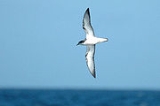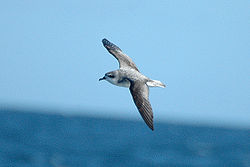
Cook's Petrel
Encyclopedia
Cook's Petrel one of the smallest petrels, is a species
of seabird
and a member of the gadfly petrel
s. The bird
is 25-30 cm in size, with a 65-66 cm wingspan. It is a member of the subgroup of petrels known as 'Cookilaria' petrels, which includes the very similar Stejneger's Petrel
.
 This species is highly pelagic, except when nest
This species is highly pelagic, except when nest
ing, which it does on offshore islands, forest ridges, or steep slopes. The Cook’s Petrel breeds only in New Zealand on three small islands: Little Barrier Island, Great Barrier Island
, and Codfish Islands. It migrates to the Pacific Ocean
from New Zealand
when it is not breeding. It sometimes can be seen well off the west coast of the United States
and well off the west coast of tropical South America
. Cook's Petrel feeds mostly on fish
and squid
, with some crustaceans taken.
Among Cook’s Petrel's features, the bill is long and black with tubular nostrils on both sides. As in all members of the order Procellariiformes, this nostril configuration enables an exceptionally acute sense of smell, which the birds use to locate food and nest sites in the dark.
Cook's Petrels use burrows
and rock crevices in which to nest, preferring sites on thickly forested ridges. The species was formerly more numerous; the current population estimate is 1,258,000 and declining. It is classified as vulnerable because it breeds on just three small islands. While Little Barrier Island's population remains stable, the other two populations are decreasing. One of these islands has introduced rats and Weka
s (a ground-dwelling member of the Rallidae
), both of which prey on eggs and nestlings of Cook's Petrel, reducing the population from 20,000 to 100. On Great Barrier Island
, introduced pigs, dogs, rats
, and cats have attacked nests and burrows, decreasing the population there.
Species
In biology, a species is one of the basic units of biological classification and a taxonomic rank. A species is often defined as a group of organisms capable of interbreeding and producing fertile offspring. While in many cases this definition is adequate, more precise or differing measures are...
of seabird
Seabird
Seabirds are birds that have adapted to life within the marine environment. While seabirds vary greatly in lifestyle, behaviour and physiology, they often exhibit striking convergent evolution, as the same environmental problems and feeding niches have resulted in similar adaptations...
and a member of the gadfly petrel
Gadfly petrel
The gadfly petrels are seabirds in the bird order Procellariiformes. These medium to large petrels feed on food items picked from the ocean surface....
s. The bird
Bird
Birds are feathered, winged, bipedal, endothermic , egg-laying, vertebrate animals. Around 10,000 living species and 188 families makes them the most speciose class of tetrapod vertebrates. They inhabit ecosystems across the globe, from the Arctic to the Antarctic. Extant birds range in size from...
is 25-30 cm in size, with a 65-66 cm wingspan. It is a member of the subgroup of petrels known as 'Cookilaria' petrels, which includes the very similar Stejneger's Petrel
Stejneger's Petrel
Stejneger's Petrel is a species of seabird and a member of the gadfly petrels. The bird is 26–31 cm in size, with a 53–66 cm wingspan....
.

Nest
A nest is a place of refuge to hold an animal's eggs or provide a place to live or raise offspring. They are usually made of some organic material such as twigs, grass, and leaves; or may simply be a depression in the ground, or a hole in a tree, rock or building...
ing, which it does on offshore islands, forest ridges, or steep slopes. The Cook’s Petrel breeds only in New Zealand on three small islands: Little Barrier Island, Great Barrier Island
Great Barrier Island
Great Barrier Island is a large island of New Zealand, situated to the north-east of central Auckland in the outer Hauraki Gulf. With an area of it is the fourth-largest island of New Zealand's main chain of islands, with its highest point, Mount Hobson, rising...
, and Codfish Islands. It migrates to the Pacific Ocean
Pacific Ocean
The Pacific Ocean is the largest of the Earth's oceanic divisions. It extends from the Arctic in the north to the Southern Ocean in the south, bounded by Asia and Australia in the west, and the Americas in the east.At 165.2 million square kilometres in area, this largest division of the World...
from New Zealand
New Zealand
New Zealand is an island country in the south-western Pacific Ocean comprising two main landmasses and numerous smaller islands. The country is situated some east of Australia across the Tasman Sea, and roughly south of the Pacific island nations of New Caledonia, Fiji, and Tonga...
when it is not breeding. It sometimes can be seen well off the west coast of the United States
United States
The United States of America is a federal constitutional republic comprising fifty states and a federal district...
and well off the west coast of tropical South America
South America
South America is a continent situated in the Western Hemisphere, mostly in the Southern Hemisphere, with a relatively small portion in the Northern Hemisphere. The continent is also considered a subcontinent of the Americas. It is bordered on the west by the Pacific Ocean and on the north and east...
. Cook's Petrel feeds mostly on fish
Fish
Fish are a paraphyletic group of organisms that consist of all gill-bearing aquatic vertebrate animals that lack limbs with digits. Included in this definition are the living hagfish, lampreys, and cartilaginous and bony fish, as well as various extinct related groups...
and squid
Squid
Squid are cephalopods of the order Teuthida, which comprises around 300 species. Like all other cephalopods, squid have a distinct head, bilateral symmetry, a mantle, and arms. Squid, like cuttlefish, have eight arms arranged in pairs and two, usually longer, tentacles...
, with some crustaceans taken.
Among Cook’s Petrel's features, the bill is long and black with tubular nostrils on both sides. As in all members of the order Procellariiformes, this nostril configuration enables an exceptionally acute sense of smell, which the birds use to locate food and nest sites in the dark.
Cook's Petrels use burrows
Burrows
Burrows is a provincial electoral division in the Canadian province of Manitoba. It was created by redistribution in 1957, and formally came into existence in the provincial election of 1958. The riding is located in the northern part of Winnipeg....
and rock crevices in which to nest, preferring sites on thickly forested ridges. The species was formerly more numerous; the current population estimate is 1,258,000 and declining. It is classified as vulnerable because it breeds on just three small islands. While Little Barrier Island's population remains stable, the other two populations are decreasing. One of these islands has introduced rats and Weka
Weka
The Weka or woodhen is a flightless bird species of the rail family. It is endemic to New Zealand, where four subspecies are recognized. Weka are sturdy brown birds, about the size of a chicken. As omnivores, they feed mainly on invertebrates and fruit...
s (a ground-dwelling member of the Rallidae
Rallidae
The rails, or Rallidae, are a large cosmopolitan family of small to medium-sized birds. The family exhibits considerable diversity and the family also includes the crakes, coots, and gallinules...
), both of which prey on eggs and nestlings of Cook's Petrel, reducing the population from 20,000 to 100. On Great Barrier Island
Great Barrier Island
Great Barrier Island is a large island of New Zealand, situated to the north-east of central Auckland in the outer Hauraki Gulf. With an area of it is the fourth-largest island of New Zealand's main chain of islands, with its highest point, Mount Hobson, rising...
, introduced pigs, dogs, rats
RATS
RATS may refer to:* RATS , Regression Analysis of Time Series, a statistical package* Rough Auditing Tool for Security, a computer program...
, and cats have attacked nests and burrows, decreasing the population there.

